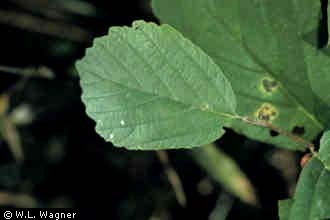Nutrition
Witch hazel, like every other flowering plant, is a photoautotroph organism that receives its nutrients primarily through the process of photosynthesis. Witch hazel will use light energy from the sun to produce chemical energy and glucose. The process of photosynthesis occurs in chloroplasts that are mainly found in the leaves of witch hazel. Photosynthesis can be categorized into two reactions; the light reaction and the dark reaction. The first to occur in witch hazel is the light reaction. Sunlight is absorbed by the pigment molecules chlorophyll, that are found in the chloroplasts. The energy from the absorbed sunlight is then converted into chemical energy that is stored as ATP in the witch hazel leaves. The ATP formed from this light reaction is used as the energy source for the dark reaction. In the dark reaction, also known as the Calvin Cycle, carbon dioxide from the atmosphere, which has already been trapped within the witch hazel’s leaves, is converted into glucose.

This picture shows a typical leaf found on a witch hazel shrub. All
of the main components of photosynthesis are found on the upper face
of the leaf.
Photo by W.L. Wagner, Jr., courtesy of Smithsonian Institution
Once glucose is produced through photosynthesis, it can be stored throughout the witch hazel plant. Eventually the glucose will need to be transported throughout the witch hazel. This is done through the Phloem, which is vascular tissue that is specialized for organic nutrient transportation throughout plants.
Wondering how witch hazel reproduces? Well you can find out Here! Or you can go back to the homepage by clicking here.